Reskilling: Tapping the talent pool
COVID-19 has resulted in massive unemployment. It may be an opportunity for warehouse operators

For years, the talent shortage was one of the leading stories in the supply chain. Whether the need was demand planners, data analysts or inventory managers at the corporate level or truck drivers or warehouse associates at the floor level, the common refrain from supply chain managers was that if recruiting talent with the necessary skills was hard, retaining them was even harder. In the warehouse, 100% annual turnover rates were more the rule than the exception.
COVID-19 exacerbated the problem, at least at first. But just as there is often a silver lining to difficult situations, COVID-19 has opened a unique opportunity in the labor market. While most sectors are witnessing all time high levels of unemployment, the warehousing and storage industry has seen little to no impact.
The reason is e-commerce. As several surveys have highlighted, the current pandemic has led to a change in consumer behavior and spending patterns. People are now shopping online more than ever before, a trend that may not change post COVID-19. In order to tap this newly available talent pool and fuel e-commerce growth, however, employers need to reevaluate what they look for in potential employees. Hence, reskilling is the way forward, and involves training this new talent pool to work efficiently in the warehousing and storage industry. To effectively scale the pool, there will need to be changes in the methods of reskilling. Moreover, there will be substantial benefits to hiring from related and unrelated industries.
This article will present data to substantiate the above points and will conclude that now is the right time to tap this newly available talent pool and to proceed with reskilling. The article will be of interest to supply chain professionals, CEOs, vice presidents, and directors and managers in supply chain, as it will provide “Think Big” ideas to grow their business.
Perfect timing
Historically, the warehousing and storage industry has witnessed a shortage of talent. Before COVID-19. The key driving factors of this shortage included historically-low unemployment rates, multiple employment options and a drive for education to pursue alternate skillsets and, hence, professions.
That was then, this is now. COVID-19 has triggered an unprecedented shift in the labor market. Overall unemployment rates have seen a 10-year high in the last 4 months; July 2020 saw unemployment rates at 10.2%. For the warehousing and storage industry, it’s a completely different picture. Although employment statistics for goods-producing and service-providing super sectors took a nosedive with declines of 5.5% and 7.9% year over year (between July 2019 and July 2020) respectively, the warehousing and storage industry went down by a mere 0.1% during the same period.
Figure 1.
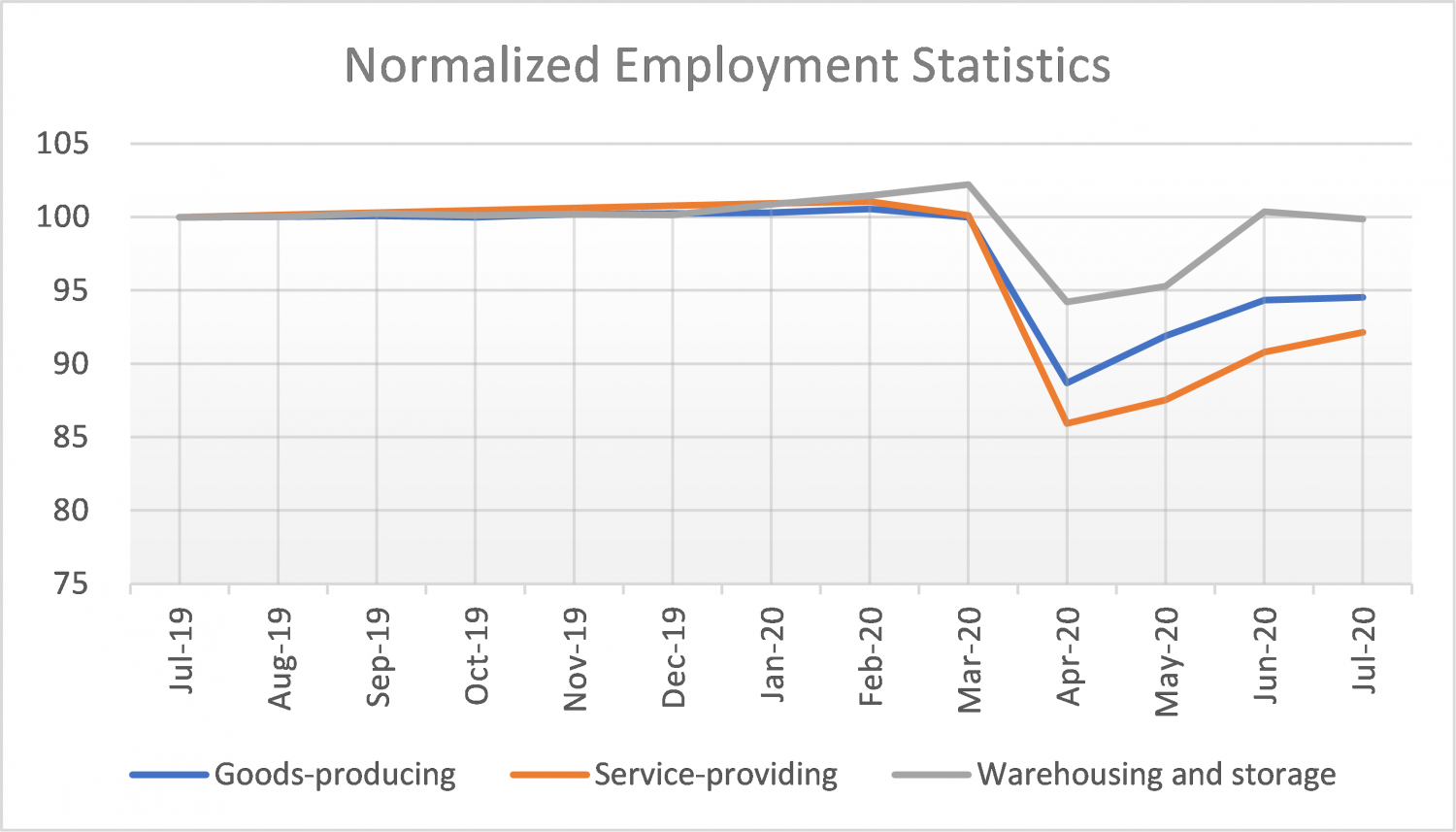
Source: Bureau of Labor Statistics; July 2019 warehousing and storage industry, goods-producing and service-providing super sectors figures normalized to 100
The majority of the e-commerce workforce is comprised of warehousing and storage industry employees. The warehousing and storage industry has seen tremendous growth in the last 10 years. The compounded annual growth rate (CAGR) for this industry was 6.4%, outpacing growth in the overall goods-producing and service-providing super sectors, which were at 1.1% and 0.6% CAGR respectively for the past 10 years.
Figure 2.

Source: Bureau of Labor Statistics; July 2010 to July 2020
While retail sales dropped 3.6% year-over-year (between Q2 2019 and Q2 2020), e-commerce sales went through the roof at a staggering increase of 44.5% year over year in the same period. For Q2 2020, e‐commerce sales stand at an all-time high of 16.1% of overall retail sales compared to 11.8% in Q1 2020. Moreover, as per a McKinsey & Company Survey on US consumer sentiment during the coronavirus crisis, digital and omnichannel adoption has continued, and even deepened, in some essential categories.
Figure 3.
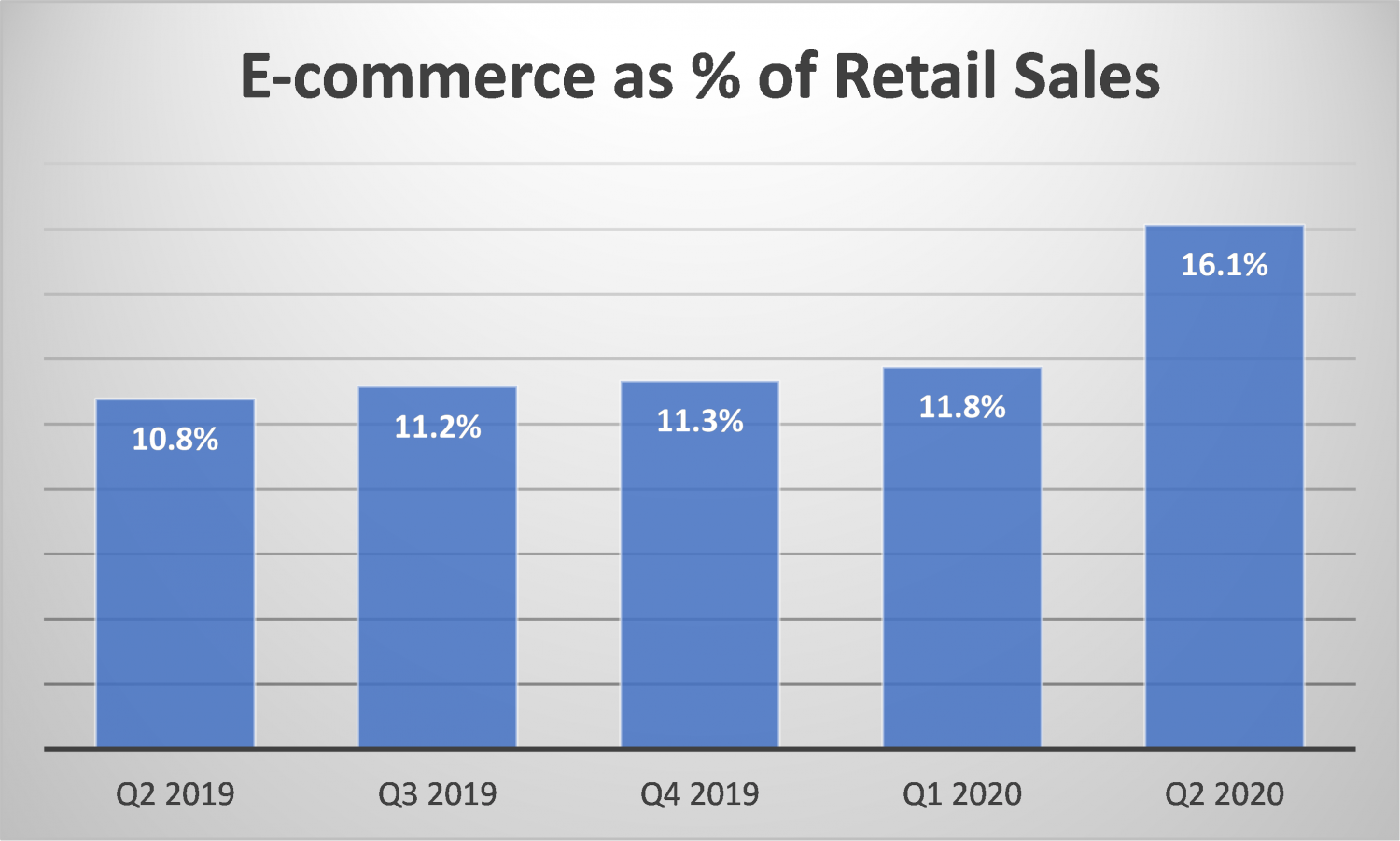
Source: Department of Commerce; provisional numbers for Q2 2020
This is likely to continue post-crisis with more consumers shopping online. According to eMarketer, retail e-commerce sales in the United States are expected to grow at 10% CAGR in the next two years. Beyond doubt, COVID-19 has impacted certain industries more than others, but this also presents a good opportunity to provide employment to displaced workers.
Hence, now is the perfect time to tap the talent pool that was historically unavailable while the need is also at an unprecedented high.
What do employers look for?
Skill sets vs cultural fit is an age-old debate in the human resources community. While most leaders agree that skill sets can be developed over time, cultural alignment is harder to achieve. Leadership, teamwork and analytical abilities are the usual non-negotiables when hiring in the industry. As ClearCompany states, about 75% of employers rate team work and collaboration as “very important,” 97% of employees and executives believe lack of alignment within a team impacts the outcome of a task or project and 86% of employees and executives cite lack of collaboration or ineffective communication for workplace failures.
Figure 4.
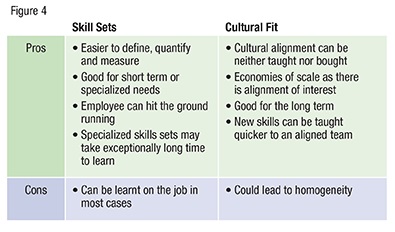
FIgure 5
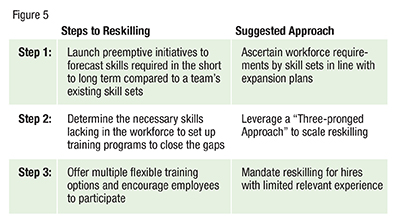
The bottom line is that cultural fit wins over technical skills in most circumstances.
Warehouse employees do need certain skill sets, but these can taught using the right methods. In addition, there are several advantages in hiring from other related or unrelated industries, which can drive innovation in the space due to diversity of thought. Fresh talent brings with it fresh inputs. Transferable skill sets drive innovation with creative ideas from other sectors and industries.
Reskilling
Reskilling essentially refers to bringing skills to groups to help them thrive going forward. Typically, employees partake in reskilling by themselves or at their employer’s request as they may have skill sets that are redundant or that no longer align with business needs. Organizations offer reskilling when they face a skills shortage and find themselves unable to fill open positions because there aren’t enough candidates with the required skills.
As the traditional labor market is saturated and a new talent pool is being tapped to fuel the e-commerce and warehousing labor demands, there is a genuine need to recalibrate the available talent pool, which involves reskilling. In this situation, it may be in the employer’s best interest to hire with cultural fit in mind, but to provide reskilling after joining.
In short, now is the time to reskill displaced workers. Not only will this help to fill the current workforce gap, but it will also help to create capacity for the future.
The amount of time spent training most warehousing and storage roles is usually less than a month. However, large-scale training for this new employee base may be challenging and therefore needs to be planned appropriately. In addition to traditional methods of training, a “Three-pronged Approach” may support bridging this gap.
• Hands-On or On-The-Job Training: Leading by example is the backbone of leadership, and what could be better than learning on the job with the team?
• Technology-Based Learning: In the current world of COVID-19, technology could substitute in-person training with virtual training and simulation-based training.
• Peer-to-Peer Learning: Of the three prongs, “Peer-to-Peer Learning” is probably the best approach to scale. Training the trainer is a suitable way forward and provides a multiplier effect for training a large group. Not only does this method apply to managers and executives, but also to hourly employees and workers.
Figure 6.
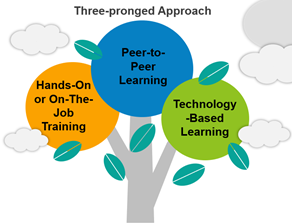
Reskilling is not just for corporations but is also for the workforce. While a change in profession of this type could prompt individuals to start from scratch and climb up the ladder, potential employees would get the opportunity to acquire a new skill set, utilize skill sets they already have that are transferable, and could potentially make them more productive than veterans because of the knowledge and skills they bring to the table. This could create healthy competition, raise the bar for the employment base and elevate the overall workforce’s performance by encompassing fresh talent and veterans.
Specialized skill sets from brick and mortar retailers and mall employees could be a value addition to stocking and packing processes. Supply chain mindsets of employees from manufacturing backgrounds could challenge the status quo in warehouses and help drive process changes. Ex-airline industry employees could drive change in scheduling, shipping and receiving. This diversity of thought and inclusion could also drive improvements in overall standards of operations in a warehouse and lead to a paradigm shift. Overall, reskilling would not only bridge a gap in the current workforce, but also up the game for the industry. Beyond doubt, reskilling is the way forward.
Disclaimer: The views and opinions expressed in this article are those of the authors and do not necessarily reflect the official policy or position of any other agency, organization, employer or company. Assumptions made in the analysis are not reflective of the position of any entity other than the author(s). These views are always subject to change, revision, and rethinking at any time. Please do not hold them in perpetuity.
About the author: Anupam Narayan is a Senior Manager at Amazon with over 10 years of experience in Operations and Finance. Prior to Amazon, he worked in Private Equity and Investment Banking. He holds a master’s in business administration from Columbia Business School and a bachelor’s in technology from the Indian Institute of Technology, Bombay. He studied Finance at London School of Economics and Political Science and was a researcher in the fields of simulation and optimization at Purdue University and Rensselaer Polytechnic Institute.

Article Topics
Blogs News & Resources
Learn from lift truck service history Two voices of reason on pallet materials 60 Seconds with Bob Trebilcock, outgoing executive editor, Modern Materials Handling The reBound Podcast: How Pitney-Bowes is innovating with autonomous vehicles. Packaging Corner: Be open to change 60 Seconds with Robert Martichenko of American Logistics Aid Network The reBound Podcast: Looking for talent in all the right places: How Essendant is revolutionizing recruitment More BlogsLatest in Materials Handling
April manufacturing output recedes after growing in March Carolina Handling celebrates anniversary with 58 for 58 giveaway Q1 sees a solid finish with strong U.S.-bound import growth, notes S&P Global Market Intelligence AutoStore to launch U.S. headquarters in greater Boston region Trew expanding manufacturing and development campus in southwest Ohio IFR: Robot installations by U.S. manufacturing companies up 12 percent last year Geek+ and System Teknik deploy PopPick solution for pharmacy group Med24.dk More Materials HandlingSubscribe to Materials Handling Magazine

Find out what the world's most innovative companies are doing to improve productivity in their plants and distribution centers.
Start your FREE subscription today.
April 2024 Modern Materials Handling

Latest Resources










